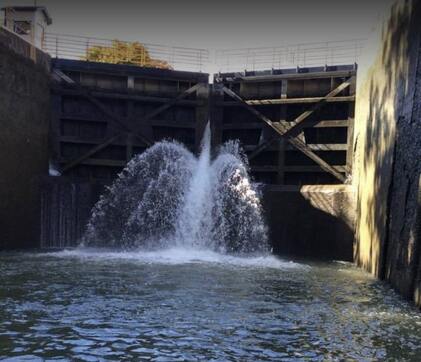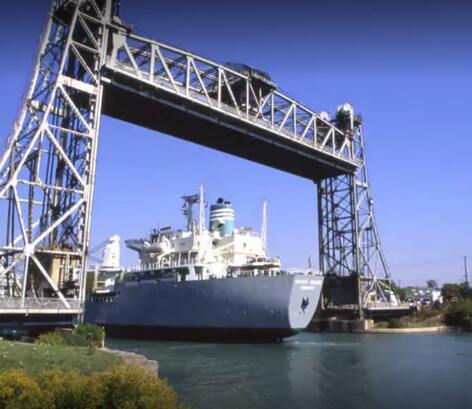
Established between 1817 and 1825, the Erie Canal is a 363 miles long waterway that travels from Albany to Buffalo and connects the Great Lake with the Atlantic Ocean through the Hudson River in upstate New York. If you plan on exploring the Erie Canal, this article will help you learn all you need to know about this national historic landmark and how you can explore it.
History of the Erie Canal
Before the construction of the Erie Canal, Americans searched for a water route connecting the East Coast to the resource-rich Great Lakes and Midwest, as it took weeks to reach them overland. In 1807, flour merchant Jesse Hawley, who went broke while trying to get his product to markets in the Atlantic coastal cities, published a series of essays advocating for a canal system that would span around 400 miles from Buffalo to Albany. Hawley’s essays caught the then NYC mayor DeWitt Clinton’s attention, who realized such a canal could change the economic face of New York. Thus began the process of building the Erie Canal near Utica, NY.
An Engineering Marvel
The construction proved challenging as the laborers had to cut through dense rock and mountainous terrain. Throughout the process, Clinton’s political opponents ridiculed the project and called it “Clinton’s ditch.” The construction took eight years as the laborers, who were Irish immigrants and American citizens, cleared the land with hand drills and blasted the rock via gunpowder.
The original Erie Canal was four feet deep and 40 feet wide, and it traversed nearly 400 miles of forests, fields, rocky cliffs, and communities. It contained 83 locks that raised and lowered boats between canal sections with differing water levels. Later, workers enlarged the canal twice to fit deeper and wider boats and rerouted parts of it to make way for increasing ship traffic.
The original canal was regarded as a significant engineering marvel when it opened on October 26, 1825, as the engineers had little experience building canals. This massive project essentially served as America’s first practical school of civil engineering.
Moreover, it was the longest artificial waterway in North America. It provided a direct water route from NYC to the Midwest, enabling large-scale agricultural and commercial development in the frontiers of Ohio, New York, Indiana, and further west.
The Erie Canal became the epitome of determination, hard work, vision, and ingenuity – the central characters of American identity. It transformed New York into the nation’s principal seaport and opened the gateway of society and settlement for interior North America. However, the subsequent population explosion along the canal route led to the dispossession of Native Americans, such as the Seneca, Oneida, Cayuga, and Onondaga, in the Upper Midwest and western New York.
The Erie Canalway National Heritage Corridor
The villages, towns, and cities that the Erie Canal passes through are named the Erie Canalway National Heritage Corridor, established in 2000. The U.S. Congress took this step to preserve this historic canal and the communities along its banks. The visitor center of this national heritage corridor is in Waterford, near the confluence of the Hudson and Mohawk Rivers. This corridor stretches 524 miles and covers the full expanse of upstate New York, from Buffalo to Albany to Whitehall. The waterway connects more than 200 communities and essentially changed the landscape of New York State.

What to Expect from the Erie Canal Tour
Today, the Erie Canal is used almost entirely for recreational activities. In fact, shipping and commercial traffic declined after the construction of the St. Lawrence Seaway in 1959. The new waterway allowed larger ships to enter the Great Lakes directly from the Atlantic Ocean.
However, the Erie Canal is still a striking historical tourism site. You can travel the length of the canal by boat or explore the Erie Canalway Trail that runs alongside the canal. The trail is open for biking, jogging, walking, and cross-country skiing. Many stretches of the train have crushed stone instead of paved pathways.
In 2020, the Erie Canalway Trail became part of the statewide Empire State Trail, which spans 750 miles. Some sections of the trail allow horseback riding, snowmobiles, inline skating, or a combination of all three. If you’re interested in these activities, plan your trip and choose the trail sections you will traverse.
If you’re planning on exploring the Erie Canal, plan your route instead of randomly picking a starting point. This way, you can ensure you see all the major tourist attractions along the canal and are close to the primary access points. Moreover, if you’re planning a multi-day trip, you will need to know about your boat’s night stops or anchor stops. You will have to find out about docks and accommodations to book ahead of time.
How to Explore the Erie Canal
Here are some ways in which you can go about exploring the Erie Canal:
Via Boating
You can choose boating if you want to explore the canal for an hour or two or go for a long stretch. Most communities along the canal have boat ramps with a few parking spaces. Some even have marinas where you can rent large boats, kayaks, and canoes. You can also take canal barges for week-long excursions exploring the Erie Canal.
With that said, if you’re covering a significant distance on the canal, you might have to go through a lock or under a lift bridge. The waterway is open for boating from mid-May through mid-November. It opens at 7 am and closes between 5 pm to 10 pm, depending on the season.
By Foot
The Erie Canalway Trail is open year-round from morning to evening. You will need a pair of trusty walking or running shoes to walk the trail along the canal. However, you might encounter snow during winter, which will slow you down. So, pack cross-country skis or snowshoes if you plan to explore the canal walkway on foot during winter. Also, be mindful of the bicyclists riding behind you in all seasons.
Via Biking
Many communities along the canal rent bicycles for whole-day or half-day trips. However, if you’re planning a more extended trip, it’s best to bring your own bike for comfort. With that said, you can also hire a bike tour service to benefit from shuttle service for the canal trail, luggage service, and more. Even though the canal trail is open all year round, you shouldn’t bike along the canal during winters as the track is rarely free of snow.
Moreover, parts of the Erie Canal trail are paved, but most of it is compacted crushed limestone. It’s best to stick with bikes with non-knobby, wide tires or mountain bikes for a smooth ride. Some parts of the trail also go to main roads and through larger towns and cities. You can explore the canal by joining a yearly bike tour that can last up to a week or ten days and cover hundreds of miles along the canal. These tours offer camping accommodations, meals, planned activities, and luggage support.
So, what are you waiting for? Explore the Erie Canal – America’s first expansive civil engineering project, which is nothing short of an engineering marvel!
